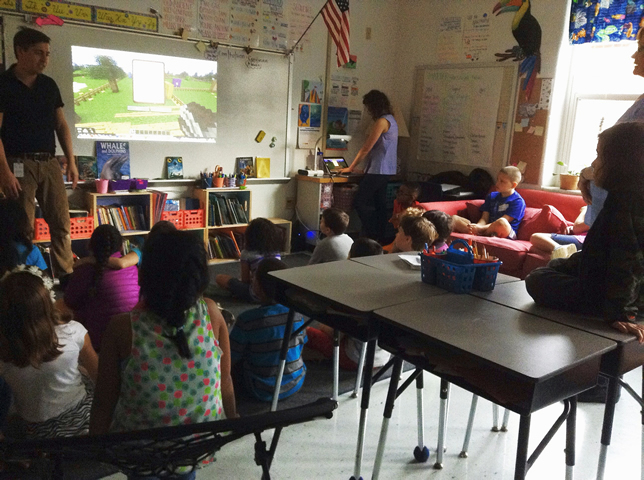Virginia District Explores MinecraftEDU as Learning Platform
- By Dian Schaffhauser
- 06/09/16
A Virginia school district has just finished up its second year of testing out the use of Minecraft in multiple schools and grade levels. Currently, 15 schools in Albemarle County Public Schools have integrated the use of Minecraft into some aspects of curriculum, and it doesn't appear that interest is flagging.
The work began in 2015 when the school system started a project to try out MinecraftEDU in support of interactive student learning. The use of interactive technologies is one of seven "pathways" established by the district to help students develop lifelong-learner competencies, alongside such aspects as maker-infused curriculum, universal design for learning and project-based learning.

Third graders at Baker-Butler Elementary explore a map created in MinecraftEDU simulating the setting of a novel they've read in class. With educators Gene Obsorn, Sarah Fagan and Jennifer Whitenack. Courtesy of Albemarle County Public Schools.
In the case of the game environment, a team came together to explore how Minecraft could help students learn how to "make individual choices" as they applied technology to their classroom work and how to interact with external people — both experts and students at other schools — for collaborative projects.
Minecraft's education edition is a version of a popular open world game, Minecraft, designed for use in a classroom. It includes secure student login IDs with individual avatars to help teachers track student activity; access to a camera feature that lets students take photos of their projects to place in a student portfolio; a "peaceful world" setting to guide students to stay on track; specialized "blocks" such as border blocks, to guide students and keep them within the world; and multi-player enhancements to let up to 30 students work together on a set of learning activities.
Jennifer Whitenack, a gifted resource teacher at Baker-Butler Elementary School, said in an email that she has been working with third and fourth grade teachers to use MinecraftEDU "as a way to extend and enhance areas of their curriculum." She emphasized that the environment isn't used as a "choice" activity, but as a "learning tool."
For example, the third graders worked in a map created by the teachers reproducing the setting of a novel they had read. That work, explained Whitenack, "included critical thinking questions about the novel that we had embedded in the map. The students actually did the work of reflecting on their reading and answering the questions while participating in the game."
The fourth graders were divided into three groups, each doing three different builds, all in the same map. One group recreated colonial Jamestown and a Powhatan village and included informational "signposts" to teach visitors about what they are seeing, an activity that "required extensive research," said Whitenack. Another group built a "math house" to test visitors' math skills. The third group built the setting of a book their reading group had just completed.
"I feel like the level of excitement and student engagement makes MinecraftEDU a powerful tool for teachers to differentiate instruction in the content areas for students of all abilities. High-achieving students can really be stretched, and struggling/reluctant students are excited about learning," she noted. "Because of how we use it, planning for a MinecraftEDU project takes considerable time and labor on the part of teachers, which not all teachers are eager to add to what they already do. I¹ve been very pleased with our work this year, and the teachers who were involved in these projects are already looking ahead to doing even more fantastic things next year."
About the Author
Dian Schaffhauser is a former senior contributing editor for 1105 Media's education publications THE Journal, Campus Technology and Spaces4Learning.